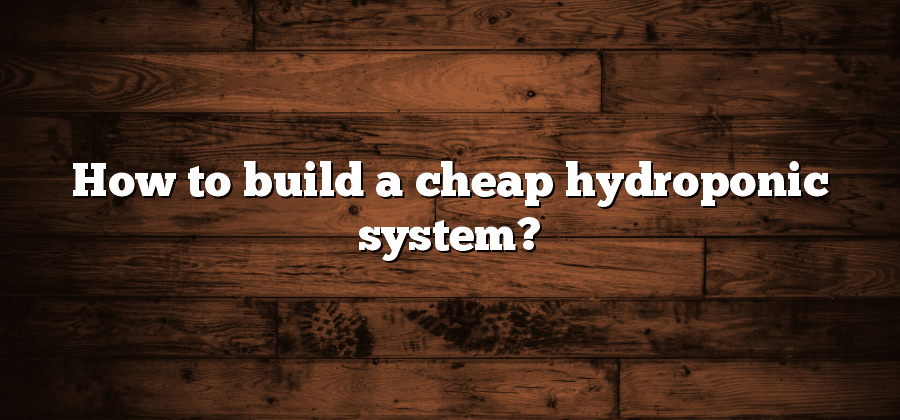Advantages of Hydroponic Systems
Hydroponic systems offer numerous advantages for growers, making them increasingly popular in agriculture and horticulture. Firstly, one of the main advantages of hydroponics is that it allows for efficient water usage. The system recirculates water, reducing water consumption by up to 90% compared to traditional soil-based methods. This not only helps to conserve water resources, but also lowers water bills for growers.
Another significant advantage of hydroponic systems is their ability to maximize crop yields. By providing plants with precise amounts of water, nutrients, and oxygen, hydroponics creates an optimal growing environment. This controlled system results in faster growth rates and healthier plants, ultimately leading to higher yields. Moreover, the controlled environment of hydroponics also minimizes the risk of disease, pests, and weeds, reducing the need for chemical pesticides and herbicides.
In addition to efficient water usage and increased crop yields, hydroponic systems also offer other advantages such as the ability to grow plants in limited spaces and the flexibility to grow crops throughout the year. Furthermore, hydroponics can be tailored to suit any plant’s specific requirements, ensuring optimal nutrient delivery and growth conditions. Overall, these advantages make hydroponic systems a compelling choice for growers looking to maximize productivity while minimizing resource usage.
Choosing the Right Container
One of the key factors in successful hydroponic gardening is choosing the right container. The container you select will play a crucial role in providing a stable environment for your plants to grow and thrive. When considering the right container for your hydroponic system, there are a few important factors to keep in mind.
First and foremost, you need to consider the size and depth of the container. The size should be appropriate for the type of plants you plan to grow and should allow for ample root expansion. Additionally, the depth of the container is important as it affects the amount of nutrient solution your plants can absorb. A deeper container will provide a larger reservoir for the roots to access water and nutrients. It is also important to choose a container made from a material that is durable and will not leach any harmful chemicals into the water. Materials like food-grade plastic or stainless steel are commonly used and provide a safe and long-lasting option for hydroponic containers.
Selecting the Ideal Growing Medium
Hydroponic systems offer a unique and efficient way to grow plants without soil. One of the key considerations when setting up a hydroponic system is selecting the ideal growing medium. The growing medium, also known as the substrate, plays a crucial role in supporting the plants and facilitating nutrient uptake.
When choosing a growing medium for your hydroponic system, it is important to consider factors such as water retention, aeration, and pH stability. Some commonly used growing mediums include perlite, vermiculite, coconut coir, and expanded clay pebbles. Each medium has its own set of advantages and considerations, so it is essential to choose one that best suits your specific needs and the type of plants you intend to grow.
Perlite, for example, is a lightweight and porous medium that provides excellent aeration and drainage. It is often used in hydroponic systems that require good oxygen circulation to the roots. On the other hand, coconut coir is a renewable and sustainable option that retains water well while still allowing for proper aeration. It is suitable for a wide range of hydroponic applications, including both water-based and media-based systems.
Selecting the ideal growing medium is a crucial step in setting up your hydroponic system for success. By understanding the characteristics and requirements of different growing mediums, you can make an informed choice that will provide optimal conditions for your plants to thrive.
Essential Nutrients for Plants
Plants, just like humans, require specific nutrients to thrive and grow. In a hydroponic system, it becomes even more crucial to provide these essential nutrients in the right amounts and proportions. Unlike traditional soil-based gardening, where plants obtain nutrients from the soil, hydroponics relies on nutrient solutions to nourish the plants directly.
The primary essential nutrients for plants are divided into two categories: macronutrients and micronutrients. Macronutrients include nitrogen, phosphorus, and potassium – commonly known as NPK. These nutrients are required by plants in large quantities to support their growth and development. On the other hand, micronutrients, such as iron, zinc, and copper, are needed in smaller quantities but are equally important for overall plant health and productivity. Maintaining a proper balance and providing these essential nutrients in the hydroponic solution is crucial to ensure optimal plant growth and abundant yields.
Optimal Lighting for Hydroponics
When it comes to hydroponics, the right lighting is crucial for the growth and development of plants. Unlike traditional soil-based gardening, hydroponic systems rely on artificial lighting to provide the necessary light spectrum for photosynthesis. This allows plants to receive the optimal amount of light required for various growth stages.
One of the most commonly used types of lighting for hydroponics is LED (Light Emitting Diode) lights. LED lights are energy-efficient and produce little heat, making them ideal for indoor gardening. They also come in a variety of colors, which can be customized to suit different plant needs. Another popular lighting option is High-Pressure Sodium (HPS) lights, which emit a high-intensity yellow-orange light spectrum that is beneficial for the flowering and fruiting stages of plant growth. Careful consideration should be given to the selection of lighting, as different plants have specific light requirements for optimal growth and yield.






